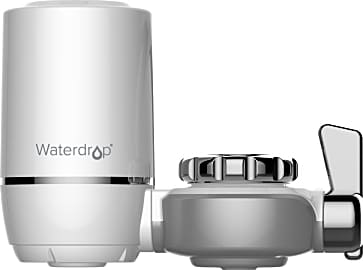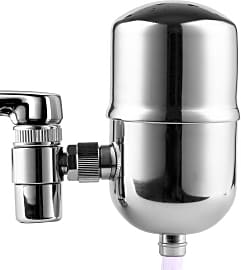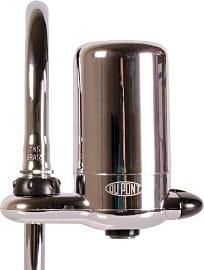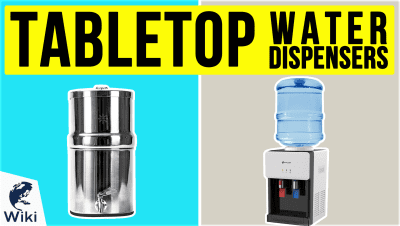The 6 Best Faucet Water Filters

This wiki has been updated 37 times since it was first published in May of 2016. Buying bottles of water is both expensive and dreadful for the environment. Whether you've tested your drinking water and got scary results or your municipality adds excessive amounts of chlorine, a faucet filter can provide you with some peace of mind. Our selections attach easily to most standard setups and provide cheap, clean, better-tasting water whenever you want it. When users buy our independently chosen editorial recommendations, we may earn commissions to help fund the Wiki.
Editor's Notes
April 23, 2020:
When looking for a faucet-mounted water filter, you'll find there isn't a lot of variety in the shape or function of these units, as they only require a housing for the filter and a simple way to mount onto your water source. In addition to saving the environment, the primary reason to add a water filter to your faucet is to save money on bottled water, so all of our choices can be installed without a professional, and most of them even without any tools.
Once you have a filter that is easy to install and won't plague you with leaks, your primary decision will be to choose what you want filtered from your water.
The Pur Advanced took the top spot for being certified to remove both lead and the pharmaceuticals that have begun to work themselves into our water supply. Both the Pur Advanced and the Brita On Tap remove most of what we don't want while leaving behind the fluoride that many communities add to their water. Some consider that a positive, while those with thyroid problems will want a different unit.
Users who prefer the fluoride is removed will want to choose the Waterdrop ACF, designed with a filtering layer just for that purpose. This model also includes six adapters to help you find the best fit for your standard faucet.
For this update we needed to remove the Aqua Elegante Advanced and the Kabter MN01, as they are no longer available. In their place we added the Engdenton Stainless for a little variety. For users who hate the idea of using plastic, this model has a stainless steel housing, so it won't crack over time. It's on the expensive side and doesn't remove as many contaminants as the top rated models, but you'll get fresh tasting, clear water with no sediment or chlorine.
Removing Impurities At The Faucet
Ensuring the safety and cleanliness of one's water throughout their home is a major consideration.
Water is a biological necessity for successfully sustaining life. It has many properties that allow living organisms to propagate. Human beings are no exception to this rule, nor are they immune to the dangers associated with contaminated drinking water. Ensuring the safety and cleanliness of one's water throughout their home is a major consideration. A faucet filter is an inexpensive way to help remove certain impurities from local water sources without the depending on an elaborate purification system.
Also referred to as a point-of-use system, the faucet water filter attaches directly to a water source (e.g. a kitchen or bathroom sink) and uses a combination of an internal mesh screen (or ceramic fabric) and granular activated carbon to trap and bond with a variety of contaminants.
When a faucet is first turned on, water passes through the device's non-woven screen and around its carbon filter. The screen traps large particles of dirt and sediment coming from the initial water line to the house. Next, water passes through the granular carbon filter. Each charcoal-based carbon granule making up the filter has millions of individual pores on its surface that adhere to additional contaminant particles, such as chlorine, benzene, and lead. This process of liquid molecule adhesion is also referred to as adsorption. Each surface pore is measured in microns, which are units of length equal to one millionth of a meter. The lower the micron rating, the smaller the filter's openings become, allowing the filter to trap increasingly smaller contaminants. Because of its capacity for mechanical filtration and ability to remove chlorine, carbon is considered the go-to choice for eliminating unpleasant odors and helping to purify the taste of a given water source. The longer a particular contaminant maintains direct physical contact with the carbon filter, the more time the filter has to trap and adsorb the impurity, meaning that a slower flow rate of water through the unit is beneficial for ensuring maximum results.
Faucet water filters remove contaminants in a similar way to many pitcher-based filters, but more quickly and without the need to carry them around. They come with adapters for accommodating sinks of different shapes and sizes. The units are often equipped with integrated valves that allow them to switch seamlessly between filtered and unfiltered water, as well. Some faucet filters even provide multi-stage operation, meaning they're adept at removing a high number of contaminants as water continues to pass through each of their internal sections. Finally, they're increasingly effective when used in conjunction with a water purification solution, such as a reverse osmosis system, removing up to 95 percent of all toxins, bacteria, and contaminants from a particular water source.
Considerations To Keep The Water Flowing
Consider a faucet filter's use of cartridges. One must understand the length of time a cartridge lasts before it needs replacing. Typical lifetime for a cartridge is around three months. However, cartridge lifetime is not an exact science in the sense that each water source varies in the number and types of impurities present. Level of impurity depends greatly on the location of your water source and the type of treatment plant through which it's been processed prior to arrival at your home. For that reason, the cartridge life of the filter will also vary. However, you should be aware of how activated carbon particles treat the water when making your decision.
Look for a filter with anti-microbial protection, as this serves to help extend the unit's lifespan. If you're worried about carbon saturation of the device cartridge, then consider a filter with an integrated LED replacement indicator to stay ahead of potential re-contamination.
Consider the filter's housing material when making your choice. Plastic faucet filters should be BPA-free. Depending on the style of your sink, filter units are also available in attractive white or chrome exteriors to complement your kitchen or bathroom decor.
A Brief History Of Faucet Water Filters
Throughout human history, water filters have been used to address the dangers associated with unfiltered water from streams, rivers, and lakes in locations with concentrated human settlements. The earliest mention of filtration technology dates back to ancient Egyptian and Sanskrit writings as early as 2000 B.C.E., detailing methods of boiling and filtering water through both sand and gravel.
Bacon believed that a hole dug close enough to the seashore would allow sand to obstruct the passage of salt in the water, resulting in pure water that was fit for drinking.
Greek physician Hippocrates designed one of the first rudimentary filters called the Hippocratic sleeve, which consisted of a cloth bag through which rainwater would be poured after it was boiled in an attempt to remove bad odors.
In his 1627 compilation, A Natural History of Ten Centuries, Sir Francis Bacon discussed the process of water desalination in the first practical scientific experimentation on the subject of filtration. Bacon believed that a hole dug close enough to the seashore would allow sand to obstruct the passage of salt in the water, resulting in pure water that was fit for drinking.
Upon the realization that the quality of drinking water directly impacted people's health, the 19th century saw the birth of the Metropolitan Water Act of 1852, calling for the requirement of all London water to be filtered.
Modern drinking water standards in the United States were enacted by the 1940s, followed by the Federal Water Pollution Control Act of 1972. This paved the way for the growing popularity of smaller units to be installed and used to filter faucet water in domestic settings. Since that time, faucet filters have continued to develop more sophisticated inner components and easy, one-click installation methods for providing consumers with as close to a universal fit on any sink as possible.











